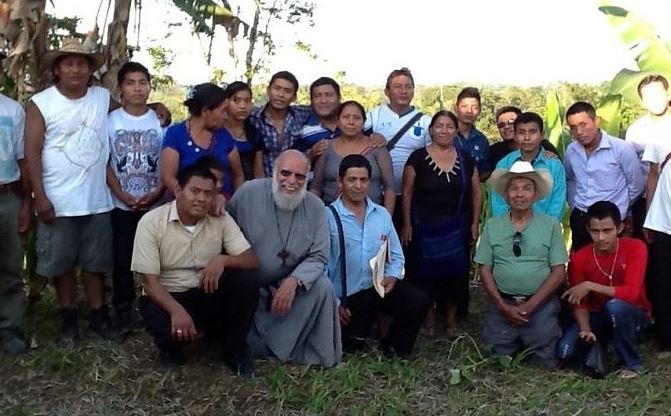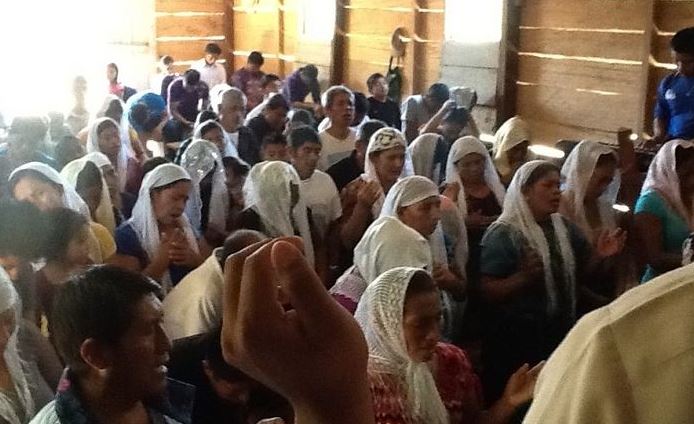
by Fr. John Chakos
Up until the late fifties, the sparsely populated jungle area of Ixcan in western Guatemala was thought to be worthless by the government. In an effort to populate the region for the benefit of the indigenous tribes, a program of land reform was initiated. Taking advantage of this opportunity, a Maryknoll priest- Father William Woods- purchased 100 square miles of inaccessible jungle land and began to form cooperatives to assist the Mayan people. With three airplanes, he and other pilots flew thousands of flights to take the produce of these cooperatives to market. Then in 1970, oil was discovered in that region.
As a result, the now settled local people were forced to plant grass on their land and leave, thus ceding their land to the rich and powerful for exploitation. As the Mayans only advocate, Woods tried to prevent this land grab by bringing their plight to the attention of the world. He was warned by the military to leave or else. Shortly thereafter his plane crashed in the jungle, and within an hour key telltale components of the plane were removed from the site by the military. Later an army officer confirmed the suspicion of foul play.
The years after the priest’s martyric death were painful for the Ixcan colonizers. A number of times Guatemala soldiers entered the Ixcan cooperatives to burn, to torture, and massacre the indigenous population. Many had to flee to Mexico or hide in the jungle in order to escape the genocide perpetrated by the Guatemala army. When those who fled were finally repatriated in 1995 they returned to the Ixcan territory to often find that their original plots of land were given to others by the army. Through subsequent Church efforts most people have recovered their lands. Their gratitude and love for Father Bill Woods has never wavered. His photo hangs in many churches. The late Fr. Andres Giron, the founder of the Orthodox Church in Guatemala and onetime leader of the campesino movement for land reform, named one of the coastal villages he founded after William Woods.
Today, the Orthodox Christians of Ixcan, who were part of this turbulent history and the violent civil war, have vivid memories of this time of trouble. With the peace accords of 1996 and the restoration of their lands, they tried to create a new life for themselves. During the years that followed, however, a period of alienation and estrangement ensued between many of the humble peasants and the area Catholic parishes to which they belonged.
They complained of indifference, neglect and even abusive treatment on the part of their clergy. After numerous efforts at reconciliation proved futile, a number of families made the decision on December 31st, 2015, to separate themselves from their mother church. It should be pointed out that in Guatemala and all of Latin America there have been massive defections from the Catholic Church since the 1970s as per a November 2014 Pew report. And so it was that in January of 2010, these disaffected Mayan communities in Ixcan petitioned to become members of the Orthodox Church under the leadership of Fr. Andres Giron. Expelled from the Catholic Church himself for his political activities, the Mayan people of Ixcan found in him a compassionate spiritual leader and defender of their rights.
I visited the faithful of Ixcan with Father Andres nearly four years ago for the first time. What I found was a faithful remnant living in the most humble of circumstances and praying in weathered shanty-like structures consisting of wooden slats, dirt floors covered with fragrant pine needles, and rusty tin roofs, from which colorful streamers hung. I call these the cathedrals of the poor, magnificent in their unassuming simplicity. Since we were visiting these remote outposts of the Church for the first time, the faithful wanted to offer us something special from their meager substance.
Some of the village men at early dawn went to the nearby river, hoping to catch a big fish in honor of Fr. Andres’ first visit. They prayed before casting their nets. Then to their surprise and delight, they caught a 30 pound fish, which they proudly presented to us upon our arrival. They saw this large piscine prize as a confirmation of their decision to throw in their lot with Fr. Andres. After this four year hiatus, I was able to visit two of the communities again this past February of 2016, at which time they showed us two newly purchased parcels of land. Fr. Evangelos, the parish priest, who visits them every two months or so, told me that he would like to make the Holy Trinity parish in Mayaland a regional center for Orthodoxy. The potential for growth is great, and the people seem very mission minded.
They feel that a proper Orthodox Church structure will give them the visibility they need to reach out and spread the faith to neighbors and friends. Presently, as before, the communities that I visited continue praying and worshiping in their temporary wooden structures. What is lacking in material beauty, however, is more than compensated for by a profound faith and spiritual vitality that shakes the very rafters of their humble churches. When homes and land were lost to them before, they found their consolation in Christ, who now has led them into the Orthodox fold. Their long journey through many trials is a great testament to their resilient faith.
May we be worthy of their trust in us.


Leave a Reply